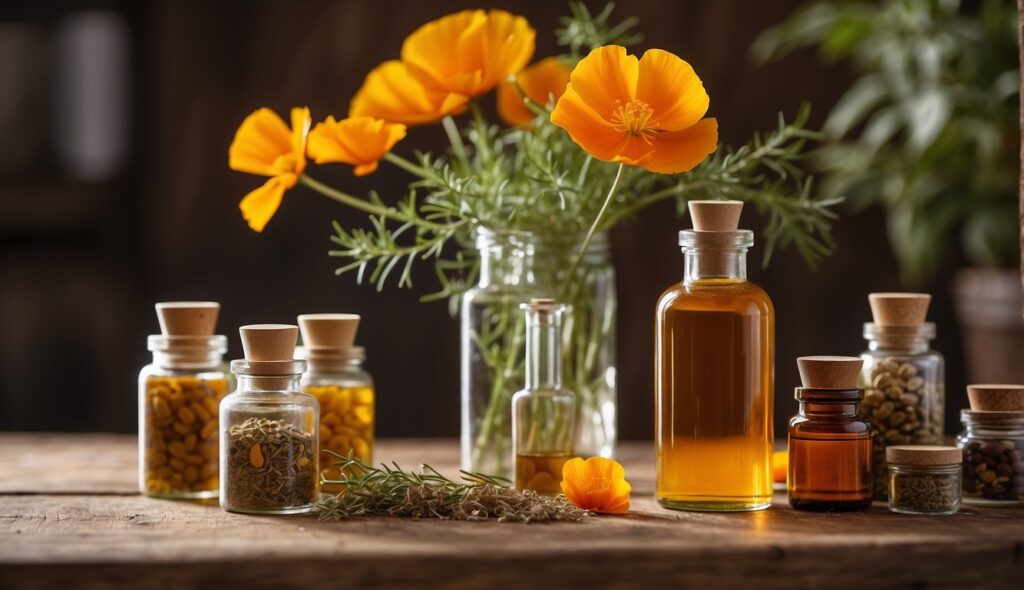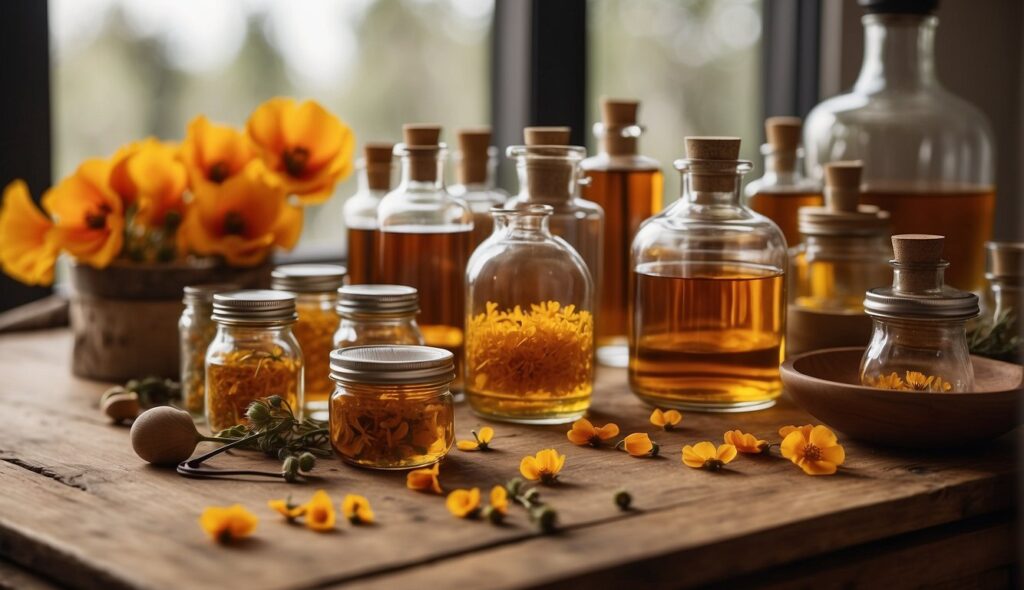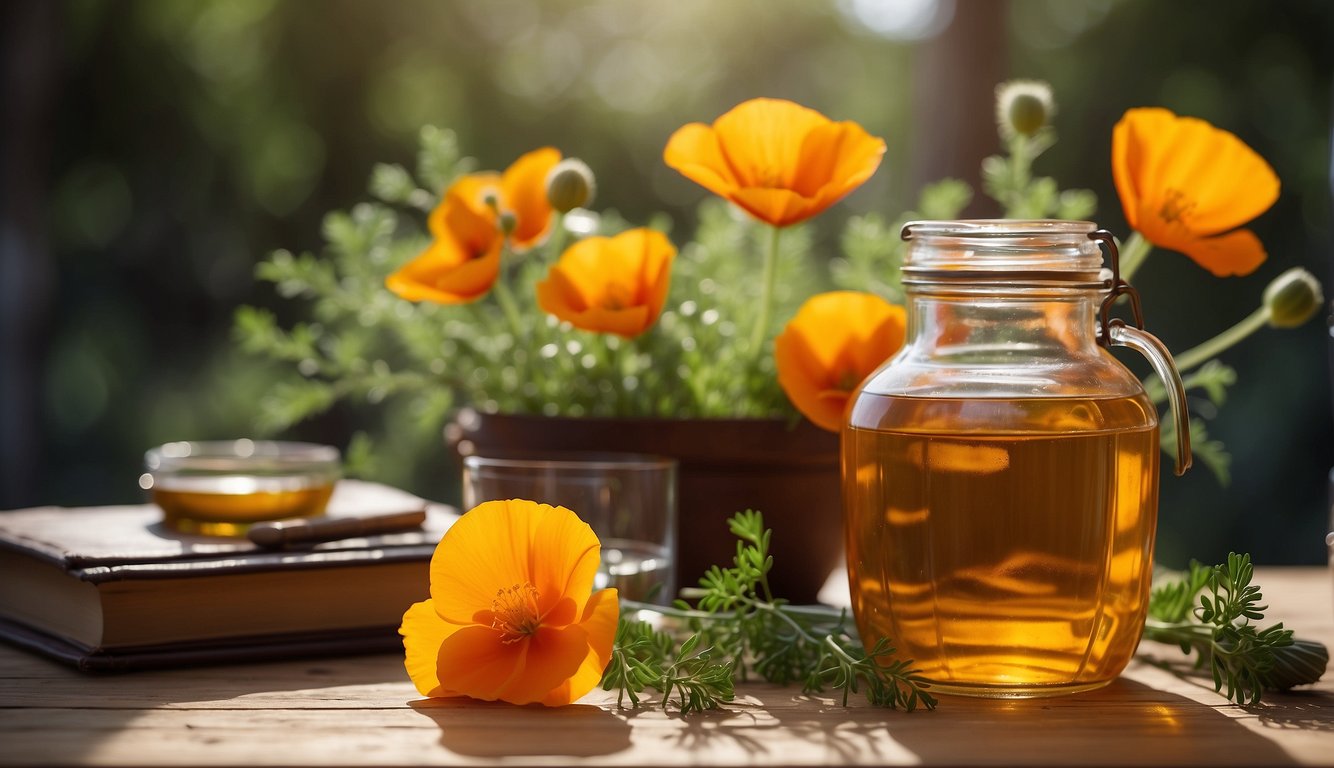I have extensive knowledge of the benefits of California poppy tincture recipe and how to make it. California poppy, also known as Eschscholzia Californica, is a plant native to California. It has been used for centuries by Native Americans as a natural remedy for various ailments.
The plant is known for its calming and relaxing effects, making it a popular choice for those looking for a natural alternative to traditional medicine. Making a California poppy tincture is a simple process that can be done at home with just a few ingredients.
The tincture is made by steeping the dried California poppy flowers and leaves in alcohol for several weeks, allowing the active compounds to be extracted. Once the tincture is ready, it can be used to help treat anxiety, insomnia, and other nervous system disorders. It is important to note that while California poppy tincture can be a helpful natural remedy, it should not be used as a replacement for medical treatment.
History and Significance
California Poppy, also known as Eschscholzia Californica, is a beautiful wildflower that is native to California and is the state flower of California.
The plant was first described by Adelbert von Chamisso, a naturalist, and botanist who was a member of the Russian Academy of Sciences. He named the plant after his friend and colleague, Johann Friedrich Eschscholtz, who was a physician and naturalist.
California Poppy: State Flower of California
California Poppy was officially designated as the state flower of California in 1903.
The flower was chosen because of its vibrant color, which represents the golden sunshine of California.
The plant is also drought-tolerant, which is important in a state that frequently experiences drought conditions.
In addition, the flower has a long blooming season, which means that it can be enjoyed for many months of the year.
Traditional Uses by Native Americans
California Poppy has a long history of use by Native Americans for medicinal purposes.
The plant was used to treat a variety of ailments, including insomnia, anxiety, and pain.
The Luiseno tribe, for example, used the flowers to make chewing gum by mixing them with natural tree gums. They also boiled and steamed the leaves to eat as vegetables. The whole plant can be cooked and eaten.
In addition to its medicinal uses, California Poppy was also used by Native Americans for religious and ceremonial purposes.
The plant was believed to have spiritual powers and was used in various rituals.
Today, California Poppy is still used by herbalists and naturopaths for its calming and sedative properties.
The plant is commonly used to make tinctures, which are alcohol-based extracts that can be taken orally.
Botanical Profile
As a herbalist, I find it important to understand the botanical profile of the plants I work with.
Identifying California Poppies
The California poppy, also known as Eschscholzia californica, is a wildflower that belongs to the poppy family.
It is a perennial plant that is native to California and Mexico, but it is also commonly found in other parts of the United States.
The California poppy is known for its brightly colored flowers that range from orange to yellow to red.
The flowers have four petals and a distinctive cup-shaped structure in the center.
The leaves of the plant are finely divided and fern-like, and they are a bluish-green color.
Growth and Habitat
The California poppy prefers dry, sandy soil and full sun exposure.
It is often found in meadows, grasslands, and along roadsides.
The plant is drought-tolerant and can survive in areas with little water.
The California poppy is an important plant in traditional Native American medicine.
It is known for its sedative and pain-relieving properties, and it has been used to treat a variety of ailments, including anxiety, insomnia, and toothaches.
Health Benefits – California Poppy Tincture Recipe
As a natural remedy, California Poppy Tincture offers a range of health benefits. Here are some of the most significant benefits of using California Poppy Tincture.
Sedative and Anxiolytic Properties
California Poppy Tincture is known for its sedative and anxiolytic properties.
The tincture contains alkaloids that bind to the GABA receptors in the brain, which helps to promote relaxation and calmness.
This makes it an excellent natural remedy for anxiety, stress, and nervousness.
Pain Relief and Anti-Inflammatory Effects
California Poppy Tincture has pain-relieving properties, making it an effective natural remedy for aches and pains.
The tincture contains natural compounds that have anti-inflammatory effects, which can help to reduce swelling and inflammation in the body.
This makes it an excellent natural remedy for conditions such as arthritis, headaches, and menstrual cramps.
In addition to these benefits, California Poppy Tincture can also help to improve sleep quality and relieve insomnia.
It is a natural nervine, which means that it helps to support the nervous system and promote relaxation.
Preparing the Tincture – California Poppy Tincture Recipe
Ingredients and Equipment
To make California Poppy Tincture, you will need the following ingredients and equipment:
- Fresh or dried California Poppy leaves, stems, and seeds
- High-proof alcohol, such as vodka or Everclear
- Glass jar with a tight-fitting lid
- Cheesecloth or fine mesh strainer
- Funnel
- Amber glass dropper bottles
Step-by-Step Process
- Start by filling the glass jar about 1/3 of the way full with the California Poppy plant material. If using fresh plant material, chop it up into small pieces.
- Pour the alcohol over the plant material, making sure to completely cover it. Use a spoon to push the plant matter down and ensure it is fully submerged.
- Seal the jar with a tight-fitting lid. If using a metal lid, place a piece of parchment paper between the lid and the jar to prevent corrosion. Alternatively, use a plastic lid.
- Store the jar in a dark, cool place, such as a pantry or cupboard. Shake the jar daily for at least two weeks, and up to six weeks for a stronger tincture.
- After the desired steeping time has passed, strain the tincture through a cheesecloth or fine mesh strainer into a clean glass jar or bowl.
- Use a funnel to transfer the tincture into amber glass dropper bottles, which will protect the tincture from light and extend its shelf life.
- Label the bottles with the date and contents, and store them in a cool, dark place. The tincture will keep for up to two years.
Dosage and Administration – California Poppy Tincture Recipe

As with any herbal remedy, it is important to follow the recommended dosage guidelines for California poppy tincture to ensure safe and effective use.
Recommended Dosage for Adults
The recommended dosage for California poppy tincture is typically 20-30 drops, taken up to three times per day.
It is best to start with a lower dose and gradually increase as needed.
For those who prefer a more standardized dosage, California poppy tincture is also available in capsule form. In this case, a typical dosage is one to two capsules, taken up to three times per day.
Special Considerations for Children
While California poppy is generally considered safe for children, it is important to consult with a healthcare professional before administering any herbal remedy to a child.
For children, a lower dosage is typically recommended. A general guideline is to use 1 drop of tincture per year of age, up to a maximum of 10 drops.
Alternatively, California poppy tea can be made by steeping 1 teaspoon of dried herb in 8 ounces of hot water for 10-15 minutes. A child’s dosage would be approximately 1/4 to 1/2 cup of tea, taken up to three times per day.
Safety and Precautions – California Poppy Tincture Recipe
California poppy tincture is generally safe when taken in recommended doses. However, like any other herb or medication, it may cause side effects such as dizziness, nausea, and sedation.
Contraindications and Cautions
California poppy tincture should not be used in individuals who are allergic to the plant or its components.
It should also be avoided in individuals with a history of addiction to opioids, alcohol, or other substances.
California poppy tincture may interact with certain medications, including sedatives, antidepressants, and painkillers.
It is important to consult a healthcare provider before using California poppy tincture if you are taking any medications.
Use During Pregnancy and Lactation
California poppy tincture should be avoided during pregnancy and lactation due to the lack of safety data.
Although there is no evidence that California poppy tincture is harmful during pregnancy or breastfeeding, it is better to err on the side of caution and avoid using it altogether.
Complementary Herbs and Supplements – California Poppy Tincture Recipe
As with any herbal remedy, California poppy tincture can be combined with other herbs and supplements to enhance its effects. Here are a few complementary options to consider:
Combining with Hawthorn and Chamomile
Hawthorn and chamomile are two herbs that can be combined with California poppy to provide additional benefits.
Hawthorn is known for its ability to support cardiovascular health and can help to lower blood pressure. Meanwhile, chamomile is a gentle sedative that can help to calm the mind and promote relaxation.
When combined with California poppy, hawthorn and chamomile can help to enhance the tincture’s calming and relaxing effects.
To use, simply add a few drops of hawthorn and chamomile tincture to your California poppy tincture or brew a tea using all three herbs.
Magnesium and Valerian Root Synergy
Magnesium is a mineral that is essential for many bodily functions, including muscle and nerve function. It is also known for its ability to promote relaxation and reduce anxiety.
Valerian root, on the other hand, is a natural sedative that has been used for centuries to promote relaxation and relieve insomnia.
When combined with California poppy, magnesium and valerian root can help to enhance the tincture’s sedative effects.
Magnesium can be taken as a supplement or added to your diet through foods like leafy greens, nuts, and seeds. Meanwhile, valerian root can be taken as a supplement or brewed into a tea.
Linking California Poppy Tincture Recipe to TheHerbProf.com
Today, we’re weaving a connection between our California Poppy Tincture Recipe and our herbal home, theherbprof.com. Intriguing, isn’t it?
Our California Poppy Tincture Recipe is a deep dive into the world of herbal tinctures. It’s a practical guide that brings the power of herbs to your health. And guess what? It’s a star feature on our website!
Now, theherbprof.com is our herbal sanctuary. It’s where we share our wisdom, our passion, and our love for all things herbal. It’s the place where you can learn about the wonders of California Poppy and why it’s such a superstar in our tincture recipe.
So, how do they help each other? Well, our California Poppy Tincture Recipe is the practical side of herbalism. It’s the hands-on, DIY experience that complements the wealth of knowledge on our website.
On the flip side, theherbprof.com provides the theory behind the practice. It’s where you can dive deeper into the world of California Poppy, understand its benefits, and learn why it’s a key player in our tincture recipe.
So, there you have it! A perfect blend of theory and practice, each enhancing the other. So, why not check out the recipe and let’s get brewing!
Remember, herbalism is a journey, and we’re here to guide you every step of the way. Happy brewing!
References – California Poppy Tincture Recipe
Little Herb Encyclopedia, by Jack Ritchason; N.D., Woodland Publishing Incorporated, 1995
The Ultimate Healing System, Course Manual, Copyright 1985, Don Lepore
Planetary Herbology, Michael Tierra, C.A., N.D., Lotus Press, 1988
Handbook of Medicinal Herbs, by James A. Duke, Pub. CRP Second Edition 2007
The Complete Medicinal Herbal, by Penelope Ody, Published by Dorling Kindersley
Check the Following Articles!
Milk Thistle Tincture Recipe: A Simple and Effective Guide
Dandelion Root Tincture Recipe: A Simple Guide
Hawthorn Tincture Recipe: Support Heart Health
Sulwhasoo Herbal Soap Review: Benefits and Drawbacks
Frequently Asked Questions – California Poppy Tincture Recipe

What are the benefits of using a California poppy tincture?
A California poppy tincture is known to provide several benefits to its users. Some of the significant benefits include helping to soothe nervous tension, ease feelings of anxiety, and improve sleep quality.
It is also known to relieve pain, including nerve-related pain, tooth pain, arthritis, headaches, menstrual cramps, and more. California poppy tincture is a non-compulsive herb that has no narcotic effects.
Can a California poppy tincture induce a euphoric effect?
No, a California poppy tincture does not induce a euphoric effect. Unlike other poppy plants, California poppy does not contain opium and is non-addictive. It is a safe and natural alternative to prescription drugs.
What are the potential side effects of taking a California poppy tincture?
California poppy tincture is generally safe when used as directed. However, some people may experience side effects, including dizziness, headaches, and stomach upset.
It is advisable to consult a healthcare professional before using California poppy tincture, especially if you are pregnant, nursing, or have a medical condition.
How does California poppy tincture aid in improving sleep quality?
California poppy tincture contains natural sedative properties that help to promote relaxation and improve sleep quality.
It works by increasing the levels of GABA in the brain, a neurotransmitter that regulates sleep and relaxation. It is an effective natural remedy for those struggling with sleep disorders.
What is the recommended dosage for a California poppy tincture?
The recommended dosage for California poppy tincture varies depending on the individual’s age, weight, and health condition.
It is advisable to start with a small dose and gradually increase it as needed. A healthcare professional can provide guidance on the appropriate dosage.
How can I make an alcohol-free California poppy tincture?
To make an alcohol-free California poppy tincture, you can use vegetable glycerin or apple cider vinegar instead of alcohol. The process is similar to making an alcohol-based tincture, but the mixture is left to steep for a longer period.
Vegetable glycerin or apple cider vinegar tinctures have a shorter shelf life than alcohol-based tinctures and may not be as potent.

